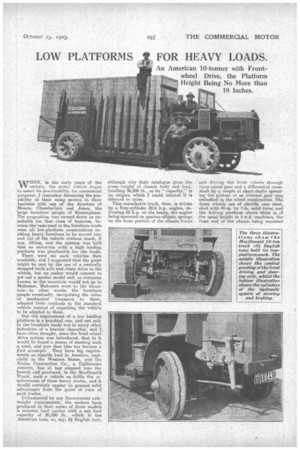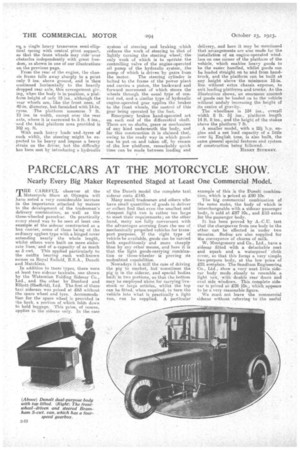LOW PLATFORMS FOR HEAVY LOADS.
Page 21

Page 22

If you've noticed an error in this article please click here to report it so we can fix it.
An American 10-tonner with Frontwheel Drive, the Platform Height Being No More than 18 Inches.
WHEN, in the barly years of the century, the motor vehicle .began to assert its practicability for commercial _ purposes, I remember discussing the possibility of their using motors in their business with one of the directors of Messrs. Chamberlain and Jones, the 'large furniture people of Birmingham. The proposition was turned down as unsuitable for that class of business, because the vans used in the furniture trade were all low-platform constructions enabling heavy furniture to be moved into and out of the vehicle without much, if any, lifting, and the opinion was held that no motorvan with a high loading platform was practicable for the trade.
There were no such vehicles then available, and I suggested that the point might be met by the use of a centrally dropped back axle and chain drive to the wheels, but no maker would consent to get out a special model and, as everyone knows, as the mountain would not go to Mahomet, Mahomet went to the mountain—in other words, the forniture people eventually, recognizing the value of mechanical transport to them, adapted their methods to the standard vehicle instead of expecting the vehicle to be adapted to them.
But the requirement of a low loading platform is a practical one, and not only in the furniture trade but in many other industries of a heavier character, and I, have often thought, since the front-wheel drive system was introduced, that in it would be found a means of meeting such a need, and now that idea has become a fait accompli. They have big requirements as, regards load in America, especially in the Western States, and the
• Union Contruction Co., a Californian
• concern, has at last stepped into the breach and produced, in the MacDonald Truck, such a vehicle as fulfils the requirements of these heavy trades, and it would certainly appear to present solid advantages from the point -of view of such trades.
Unhampered by any Government axleweight requirements, the makers have
' produced in their series of three models a monster load carrier with a net load capacity of 20,000 lb., which is ten American tons, or, say, 8/ English tons, although why theircataloo•ue gives the gross weight of chassis body and load, totalling 36,000 lb., as its "capacity," is an enigma which I could unravel if it referred to tyres.
This remarkable truck, then, is driven by a four-cylinder 32.6 h.p. engine, delivering 52 b.p. on the brake, the engine being mounted on quarter-elliptic springs on the front portion of the chassis frame and driving the front wheels through . three-speed gear cud a differential crossshaft by a couple of short shafts operating the pinions of an internal ,gear ring embodied in the wheel construction_ The front wheels are of electrlic cast steel, shod with 40-in. by 7-in, solid tyres, and the driving platform above them is., of _the usual height in f.w.d. machines, the front end of the ehassis being mounted
orl, a single heavy transverse semi-elliptical spring with central pivot support, sothat the frcutt wheels may rideover obstacles independently with great freedom, as shown in one of our illustrations on the previous page.
From the rear ot the engine, the chassis frame falls away sharply to a point only 9 ins: above ground, and is then continued horizontally to the heavily dropped rear axle, this arrangement
ing, when the body is inposition, a platform height ef only 18 ins. although the rear wheels ate' like the front ones, of 40-in. diameter, but furnished with 14-in. tyres. The platform measures 7 ft. 10 ins, in width, except over the rear axle, where it is narrowed to 5 ft. 6 ins., and the total platform area provided is 102 sq. ft.
With such heavy 'loads • and -tyres of SI/ch width, the steering might he expected to be heavy and impose a heany
strain on the driver, but the difficulty has been met by introducing a hydraulic
system of steering and braking which seduces the work of steering to that of lightly turning the steeling wheel; the only work of which is to open-ate the controlling valve of the engine-operated oil pump of the hydraulic system, • the pomp of which is driven .by gears from the motor. The steering cylinder is bolted to the frame of the power plant and. carries a piston, the backward and forward movement of which steers the wheels through the usual type of Control rod, and a similar type of hydraulic engine-operated gear applies the brakes to the front wheels, the control ef this gear being operated by the foot.
Emergency brakes hand-operated act on each end of the differential shaft. There are no shafts, gears or mechanism of any kind underneath the body, and for this construction it is claimed that, owing to the ready way in which goods can be put on and taken off, by reason of ,the_ low platform, remarkably quick time can be made between loading and
delivery,,, and here it may be mentioned that arrangements are also made for the installation of an engine-operated windlass on one etirner of the platform of the vehicle, which enables heavy goods to be the easier handled, whilst goods can be loaded straight on to and from handtruck, and the platform can be built at any height above the minimum 19-iu. line without extra chassis expanse, to suit loading platforms and trucks. As the illustration shows, an enormous: amount of goods can be loaded on to the vehicle without unduly increasing the height of its centre of gravity.
The wheelbase is 184 ins,, overall width 8 ft. 51 ins., platform length 14 ft. 8 ins-, and the height of the stakes above the platform'? ft.
A smaller model, with a 22k hp. engine and a net load capacity of a little over .5i English tons, is also bnflt, the same general special features and system of construction being followed.
FENRY STIMMEY.






























